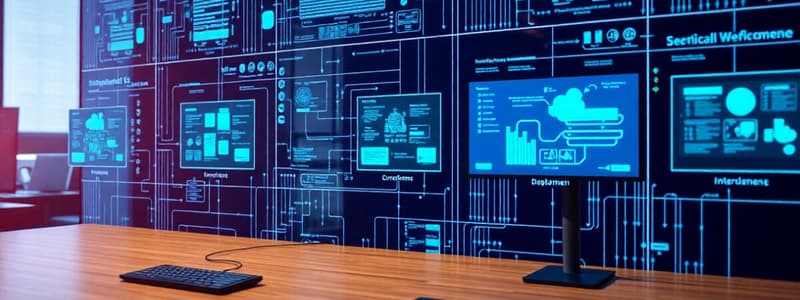Podcast
Questions and Answers
Which of the following is not a general approach to acquiring information processing functionalities?
Which of the following is not a general approach to acquiring information processing functionalities?
- System selection and acquisition
- Custom design and development
- End-user development
- Open source development (correct)
What are the key steps during the implementation phase of the Systems Development Life Cycle (SDLC)?
What are the key steps during the implementation phase of the Systems Development Life Cycle (SDLC)?
- Programming, Testing, Installation
- Investigation, Installation, Operations
- Installation, Operations, Maintenance (correct)
- Design, Development, Deployment
Which phases of the systems development life cycle (SDLC) differ most substantially from the system selection process?
Which phases of the systems development life cycle (SDLC) differ most substantially from the system selection process?
- Build
- Testing
- Definition
- A and B (correct)
What is one of the principal risks associated with information system outsourcing?
What is one of the principal risks associated with information system outsourcing?
How does technology change influence an organization over time?
How does technology change influence an organization over time?
What is an overlooked aspect that can critically affect business success?
What is an overlooked aspect that can critically affect business success?
Which is a challenge typically faced in coordinating with an outsourced provider?
Which is a challenge typically faced in coordinating with an outsourced provider?
What is one key benefit of purchasing off-the-shelf software?
What is one key benefit of purchasing off-the-shelf software?
Which phase follows the definition phase in the software selection process?
Which phase follows the definition phase in the software selection process?
In the parallel installation approach, how are the old and new systems managed?
In the parallel installation approach, how are the old and new systems managed?
What is the main goal of knowledge infusion by software vendors?
What is the main goal of knowledge infusion by software vendors?
What is true about the pilot installation approach?
What is true about the pilot installation approach?
What approach is described as the most radical during software installation?
What approach is described as the most radical during software installation?
Which term refers to creating a model to gather user input for interface design?
Which term refers to creating a model to gather user input for interface design?
One significant benefit of end-user development is:
One significant benefit of end-user development is:
What is one benefit of end-user development for end-users?
What is one benefit of end-user development for end-users?
Which risk is associated with unreliable quality standards in end-user development?
Which risk is associated with unreliable quality standards in end-user development?
What is meant by the term 'make and buy' in software development?
What is meant by the term 'make and buy' in software development?
How can end-user development increase the pressure on the IS function?
How can end-user development increase the pressure on the IS function?
What is the primary goal of technical feasibility analysis?
What is the primary goal of technical feasibility analysis?
Which analysis ensures that a proposed new system is justifiable based on a cost benefit analysis?
Which analysis ensures that a proposed new system is justifiable based on a cost benefit analysis?
What is a risk associated with the high incidence of errors in end-user developed applications?
What is a risk associated with the high incidence of errors in end-user developed applications?
What is a potential continuity risk in end-user development?
What is a potential continuity risk in end-user development?
What is the primary goal of Customer Relationship Management (CRM)?
What is the primary goal of Customer Relationship Management (CRM)?
What advantage does open source software have regarding costs?
What advantage does open source software have regarding costs?
Which of the following is a disadvantage of open source applications?
Which of the following is a disadvantage of open source applications?
What does behavioral feasibility assess in a new system?
What does behavioral feasibility assess in a new system?
What characteristic commonly associated with enterprise systems could pose challenges?
What characteristic commonly associated with enterprise systems could pose challenges?
Why should security be a consideration for managers?
Why should security be a consideration for managers?
What does the term 'Robustness' mean in the context of open source applications?
What does the term 'Robustness' mean in the context of open source applications?
What is a potential issue with the support of open source software?
What is a potential issue with the support of open source software?
What distinguishes a Trojan Horse from other types of malware?
What distinguishes a Trojan Horse from other types of malware?
Which principle of Fair Information Practices emphasizes the right of individuals to know how their data is used?
Which principle of Fair Information Practices emphasizes the right of individuals to know how their data is used?
What is the primary function of worms in the context of computer security?
What is the primary function of worms in the context of computer security?
Which of the following best describes spyware?
Which of the following best describes spyware?
What is the goal of a Denial-of-Service Attack?
What is the goal of a Denial-of-Service Attack?
The principle of harm minimization in an Ethics Code of Conduct is primarily focused on which aspect?
The principle of harm minimization in an Ethics Code of Conduct is primarily focused on which aspect?
Which principle of Fair Information Practices relates to individuals’ ability to correct their records?
Which principle of Fair Information Practices relates to individuals’ ability to correct their records?
What is a key characteristic of an Information Systems Ethics Code of Conduct?
What is a key characteristic of an Information Systems Ethics Code of Conduct?
What is the primary purpose of firewalls in an organization?
What is the primary purpose of firewalls in an organization?
Which of the following is a typical use of encryption in organizations?
Which of the following is a typical use of encryption in organizations?
What challenge is often faced regarding information system ethics?
What challenge is often faced regarding information system ethics?
Which of the following correctly describes the role of IT and IS?
Which of the following correctly describes the role of IT and IS?
Moore’s Law states that the cost of storage continues to increase by what percentage?
Moore’s Law states that the cost of storage continues to increase by what percentage?
What is an example of a first degree change associated with the introduction of new technology?
What is an example of a first degree change associated with the introduction of new technology?
What level of organizational change does automating processes represent?
What level of organizational change does automating processes represent?
Which of the following is a consequence of outsourcing call center operations?
Which of the following is a consequence of outsourcing call center operations?
Flashcards
IS Outsourcing Risks
IS Outsourcing Risks
Outsourcing information systems can present challenges like hidden coordination costs and a deceptive underestimation of its importance.
System Acquisition Approaches
System Acquisition Approaches
Acquiring information systems can use custom design, selecting existing systems, or end-user development.
SDLC Implementation Steps
SDLC Implementation Steps
The implementation phase of the system development life cycle (SDLC) includes installation, operations, and maintenance.
Manager Involvement in SDLC
Manager Involvement in SDLC
Signup and view all the flashcards
Difference Between SDLC & System Selection
Difference Between SDLC & System Selection
Signup and view all the flashcards
Steering Committee and TCO
Steering Committee and TCO
Signup and view all the flashcards
IS Funding Methods
IS Funding Methods
Signup and view all the flashcards
SDLC phases
SDLC phases
Signup and view all the flashcards
Faster Roll-Out
Faster Roll-Out
Signup and view all the flashcards
Knowledge Infusion
Knowledge Infusion
Signup and view all the flashcards
Economically Attractive
Economically Attractive
Signup and view all the flashcards
High Quality
High Quality
Signup and view all the flashcards
Software Installation Approaches
Software Installation Approaches
Signup and view all the flashcards
Prototyping in SDLC
Prototyping in SDLC
Signup and view all the flashcards
Off-the-Shelf Application Selection
Off-the-Shelf Application Selection
Signup and view all the flashcards
Behavioral Feasibility
Behavioral Feasibility
Signup and view all the flashcards
CRM (Customer Relationship Management)
CRM (Customer Relationship Management)
Signup and view all the flashcards
Open Source Applications Advantages
Open Source Applications Advantages
Signup and view all the flashcards
Open Source Applications Disadvantages
Open Source Applications Disadvantages
Signup and view all the flashcards
Risk Audit
Risk Audit
Signup and view all the flashcards
Security's Importance for Managers
Security's Importance for Managers
Signup and view all the flashcards
Enterprise Systems
Enterprise Systems
Signup and view all the flashcards
Open Source Applications Defined
Open Source Applications Defined
Signup and view all the flashcards
Trojan Horse
Trojan Horse
Signup and view all the flashcards
Worm
Worm
Signup and view all the flashcards
Spyware
Spyware
Signup and view all the flashcards
Denial-of-Service Attack
Denial-of-Service Attack
Signup and view all the flashcards
Notice (Fair Information Practice)
Notice (Fair Information Practice)
Signup and view all the flashcards
Choice (Fair Information Practice)
Choice (Fair Information Practice)
Signup and view all the flashcards
Access (Fair Information Practice)
Access (Fair Information Practice)
Signup and view all the flashcards
Security (Fair Information Practice)
Security (Fair Information Practice)
Signup and view all the flashcards
End-User Development: Benefits
End-User Development: Benefits
Signup and view all the flashcards
End-User Development: Reduced IS Burden
End-User Development: Reduced IS Burden
Signup and view all the flashcards
Make or Buy vs. Make and Buy
Make or Buy vs. Make and Buy
Signup and view all the flashcards
Risks of End-User Development: Quality
Risks of End-User Development: Quality
Signup and view all the flashcards
Risks of End-User Development: Errors
Risks of End-User Development: Errors
Signup and view all the flashcards
Risks of End-User Development: Continuity
Risks of End-User Development: Continuity
Signup and view all the flashcards
Risks of End-User Development: IS Overburden
Risks of End-User Development: IS Overburden
Signup and view all the flashcards
Feasibility Analysis: Purposes
Feasibility Analysis: Purposes
Signup and view all the flashcards
Firewall
Firewall
Signup and view all the flashcards
Where Firewalls are used
Where Firewalls are used
Signup and view all the flashcards
Encryption
Encryption
Signup and view all the flashcards
Encryption Uses
Encryption Uses
Signup and view all the flashcards
Information System Ethics
Information System Ethics
Signup and view all the flashcards
Challenges of IS Ethics
Challenges of IS Ethics
Signup and view all the flashcards
First Order Change
First Order Change
Signup and view all the flashcards
Second Order Change
Second Order Change
Signup and view all the flashcards
Study Notes
Change Requirements
- Technological and business changes affect organizations over time.
- Coordination efforts between firms and outsourced providers are costly.
- Firms often underestimate the crucial role of information systems in business success.
Essay Questions
- Describe the relationship between the steering committee and the total cost of ownership of an IS project.
- Describe the drivers and risks of IS outsourcing.
- Describe typical IS systems funding methods, including advantages and disadvantages of each method. Provide 2 examples.
Chapter Eleven: Creating Information Systems
Multiple Choice Questions
-
General approaches to acquiring information processing functionalities include: Custom design and development, System selection and acquisition, End-user development, Open source development.
-
Open source development is NOT one of these approaches.
-
Implementation phase steps of the Systems Development Life Cycle (SDLC) include Programming, Testing, and Installation
Additional Questions
-
General or functional managers are most involved in the implementation phase.
-
System selection and SDLC differ substantially during the implementation phase.
-
The three generic phases of a system life-cycle process are Definition, Design, and Implementation.
-
The Systems Development Life Cycle Methodology is often referred to as the waterfall model because phases are sequential and iteration (or going back) should be avoided.
-
System selection process involves compiling an RFP, developing a vendor short list, and soliciting proposals.
-
Approaches to acquiring information processing functionalities include: Custom Design, Custom Development, System Selection and Acquisition, End-user Development, and Open Source Development.
-
The advantages of making your own systems include: Unique Tailoring, Flexibility, Control, but not Faster Roll-Out.
-
The advantages of purchasing off-the-shelf systems include: Faster Roll-Out, Knowledge Infusion, Economical Attractiveness, and High Quality but not Unique Tailoring.
-
The Systems Development Life Cycle has three major phases: Definition, Build, and Implementation..
-
IS department workers who are experts in both technology and business processes are called IS specialists.
-
The SDLC stage where a "go" or "no-go" decision is made is Feasibility Analysis.
-
Migration approaches for upgrading computer systems include Parallel, Direct, Phased, and Pilot.
-
The Build phase of the SDLC isn't used to ensure software integration.
-
SDLC and Prototyping are not the same methodologies.
-
Off-the-shelf systems enhance organizational knowledge infusion.
-
End-user development is where non-IT specialists create applications.
-
Custom software development is a systems approach that emphasizes design and development projects.
-
System analysts create the structure of a system, based on requirements documents.
-
Two advantages of custom software development include Unique Tailoring and Flexibility and Control.
-
Two advantages of purchased software are Faster Roll-Out and reduced implementation time.
-
Principle phases of the SDLC include Definition, Build, and Implementation.
-
Software installation approaches include Parallel, Direct, Phased, and Pilot approaches.
-
Prototyping is used in an SDLC to get user requirements.
-
End-user development leads to increased speed of development due to faster independent completion.
-
End-user development risks include Unreliable Quality Standards, High Incidence of Errors, Continuity Risks, and Increased Pressure on the IS function.
-
End-user development can result in positive user satisfaction and reduces IS workload by letting users design their own features.
-
"Make or Buy" is the idea that off-the-shelf software is frequently configured and adjusted before deployment.
Chapter 12 (Irrelevant)
Chapter 13 (Security, Privacy, and Ethics)
-
Risk Audit is the basis for Risk Analysis.
-
Security is a concern for managers because of underfunding.
-
Security is a negative deliverable because it lacks revenue.
-
Mitigation strategies include Acceptance, Avoidance, Reduction, and Transference (with increased potential for failure associated with avoidance).
-
Insurance costs are most strongly associated with risk Transference.
-
Risk mitigation is about matching the appropriate response to security threats with a desired level of security and cost.
-
Strategies for security threats include Acceptance, Avoidance, Reduction, and Transference..
-
Internal security threats include disgruntled or negligent employees.
-
External threats include intrusion, social engineering, phishing, security weaknesses, backdoors, and malicious code.
-
Examples of malicious code include viruses, Trojan horses, and worms.
-
IT risk management involves identifying, measuring, and devising optimal mitigation strategies for information system security risks..
Studying That Suits You
Use AI to generate personalized quizzes and flashcards to suit your learning preferences.




